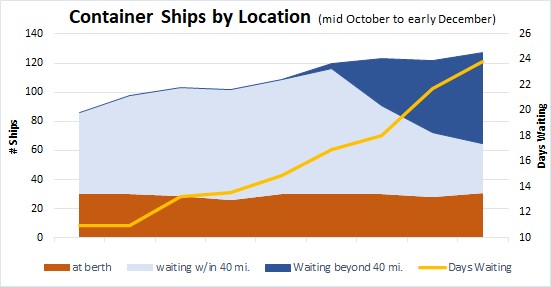President Joe Biden, Transportation Secretary Pete Buttigieg, and other Democrats are hiding, not fixing, congestion at California’s ports. This is another example of Democrats placing their image ahead of the public’s well-being. Meanwhile, the problem is worsening.
At recent press conferences, Biden administration and California officials bragged about a 37 percent drop in the number of containers stacked more than eight days on land at Los Angeles and Long Beach; a 20 percent reduction in the number of container ships spending more than nine days at the docks; and a more than 40 percent drop in the number of ships waiting within 40 miles of both ports.
Thus, they proclaim, “Our solutions are working.” Each boast is a half-truth. The whole truth is: The container pile-up has moved elsewhere and increased. Ships wait longer to berth. The ship queue has moved farther offshore.
The pileup has moved offshore and to temporary storage sites on land. Private companies set up temporary sites in recent weeks. Containers shuttled there are omitted from the ports’ official count of landed containers waiting to be hauled across the United States.
Even more containers wait offshore. They sit on a Los Angeles and Long Beach ship queue that increased 30 percent between late October and early December. Late October was when authorities announced they would fine companies for containers lingering too long on land. A queued vessel is defined as waiting to tie up to a dock.
Thirty percent more waiting vessels equates to about 150,000 more 20-foot containers floating offshore. That 150,000 is several times the contemporaneous decrease in containers stacked on land.
Pouring salt into the wound, the 150,000 additional floating containers wait longer, as do all other floating containers. Wait times more than doubled between mid-October and early December, from about 11 days towards 24 days.
Harms caused by longer wait times overwhelm benefits from the “20 percent reduction in the number of container ships spending more than nine days at the docks.” By way of illustration, 3,000-plus ship days are now spent waiting to enter Los Angeles and Long Beach. Three thousand days is at least 150 times the ship days saved by the 20 percent reduction in the number of ships at berth more than nine days.
Ship days are estimated by multiplying the number of waiting (or berthed) ships by wait (or excess berth) time. Yes, much Kentucky windage underlies this metric, but the associated point will survive refinements.
The number of ships waiting within 40 miles of Los Angeles and Long Beach declined because most now wait more than 40 miles away. As of early December, 34 were within 40 miles while 62 were farther away. Far offshore ships have waited between San Francisco, Baja, Taiwan, and Japan. They did so with “official encouragement.”
Scattering waiting ships across the Pacific Ocean eliminates the aerial photos that embarrassed President Biden, Buttigieg, California Democrats, bureaucrats, and others. However, scattering vessels did not shorten the ship queue. The queue set another record high in early December.

Graph derived from author tabulations of data from The Marine Exchange of Southern California as reported by Western Overseas and FreightWaves, the Port of Los Angeles, and the Port of Long Beach.
For more data, go here for the Port of Los Angeles daily reports, the Port of Long Beach reports, and The Marine Exchange of Southern California. All support points made above.
The offshore container pileup, ship queue, and wait times will not go away and may worsen until fundamental causes are fixed. Cures include easing regulations limiting the number of trucks and drivers available to haul more freight from California to destinations across the United States.

